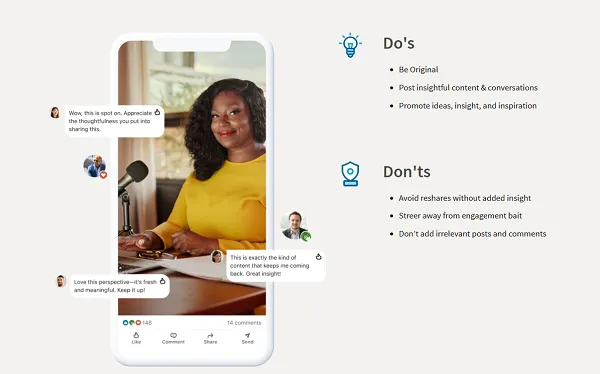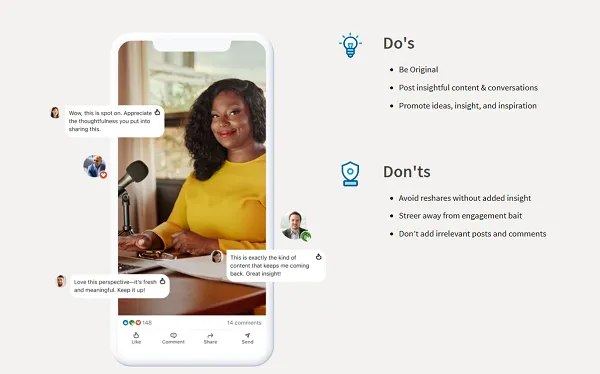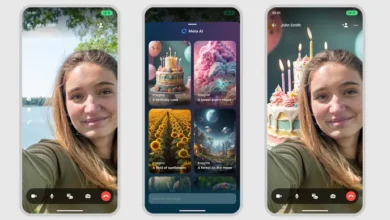LinkedIn Shares Notes on Posting Do’s and Don’ts

LinkedIn has shared some new notes on what you should be looking to post in the app, as well as the types of content that will get penalized by its feed algorithm, in order to help you maximize your content performance in the app.
Though its posting recommendations are not overly insightful:

The misspelling of “streer” also stands out, but overall, LinkedIn’s posting tips ae pretty much what you’d expect: Share original thoughts and insights, don’t post spam and engagement bait.
Its tips on what not to post provide more insight, especially considering that they’re based on what LinkedIn’s feed algorithm will look to restrict.
This note, in particular, stood out:
“Refrain from posts that create negativity and discourage engagement – While members value diverse opinions and perspectives that encourage healthy debates, it’s important to keep the conversations professional and civil. Content that fosters dismissive, derisive, and unconstructive conversations damage relationships, stifle dialogue and makes it harder for our members to have meaningful discussions.”
Specifically, LinkedIn highlights three types of negative posts in this category:
- Dismissive: content that shuts down or dismisses others’ opinions, experiences, or identities, making them feel like their perspective doesn’t matter.
- Derisive: content that mocks or makes fun of people or groups, often using sarcasm or talking down to others.
- Unconstructive: content that disrupts conversations, like shouting, using swear words, provoking arguments, or exaggerating to create fear or upset others. Humor is welcome, but avoid jokes at others’ expense, corporate memes, viral videos, or mocking.
Amazingly, this is almost like a playbook on how to succeed on X, but LinkedIn’s basically telling users not to be mean, because its algorithm is trained to penalize you for such.
How exactly does LinkedIn detect posts that violate these rules, outside of user reports? I don’t know, maybe a combination of negative keywords (bad language obviously), and by measuring the responses in the comments. But LinkedIn says that content that fails to meet its standards “may not get shared beyond your connections and followers.”
LinkedIn’s other things to avoid are:
- Content that solely attempts to promote or sell products, services, or events without also offering useful insights, news, or advice.
- Irrelevant or off-topic comments on another piece of content, including comments made just to promote unrelated products, services, or links are also discouraged (this also includes engagement pods)
- Images with text meant for humor or commentary on culture or world events without added professional context or value.
- Content or actions that explicitly ask for likes, shares, comments, or follows.
- Copying and posting someone else’s content
- Adult content (LinkedIn says that it’s best to avoid content that includes non-sexual nudity, while sexual nudity is definitely a no go).
- Content that may be sensitive or unsettling, such as images related to injuries and death (including of animals).
So, most of those are also pretty straightforward, and standard for social apps, though the note on posting things “without added professional value” is an interesting point.
LinkedIn has been trying to reduce the presence of overly personal posts that offer no professional relevance in the app, which saw big growth after the pandemic. With more people working from home, more started to post about their personal lives, which drove engagement, and eventually led to LinkedIn looking more like Facebook for a time.
But last year, LinkedIn updated its algorithm to put more focus on professional expertise and insight, which is likely what this statement refers to. LinkedIn doesn’t care about what you had for dinner, but it does care about people sharing their valuable business knowledge, which should be the focus.
These are some helpful notes, and in combination with LinkedIn’s other notes on how its algorithm now seeks to promote professional content, they could help you optimize your LinkedIn strategy, and get more out of the platform in 2025.
Also, posting video will help. LinkedIn recently reported that “immersive video views” have increased 6x quarter-over-quarter, while total video viewership in the app is up 36% year-over-year.
In combination, these tips could help you maximize your LinkedIn approach.
Source link




